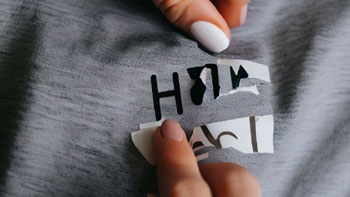Say goodbye to vinyl, and hello to your true style. Removing vinyl from shirts is easy and fast, so you can get back to rocking your own unique look.
Ready to take the “oops” out of your fashion statement? We’ve all been there—stuck with a vinyl design on a shirt that seemed like a good idea at the time.
Whether it’s glitter vinyl, a vinyl sticker, or even everyday iron-on vinyl, removing it doesn’t have to be a Herculean task. From heat presses and hair dryers to good old rubbing alcohol, I’ve got you covered with multiple ways to easily remove that unwanted vinyl.
You can do all of this right in the comfort of your home! So sit back, grab your item—whether it’s your kid’s football shirt, a backpack, or your nylon jacket—and let’s get that vinyl unstuck.
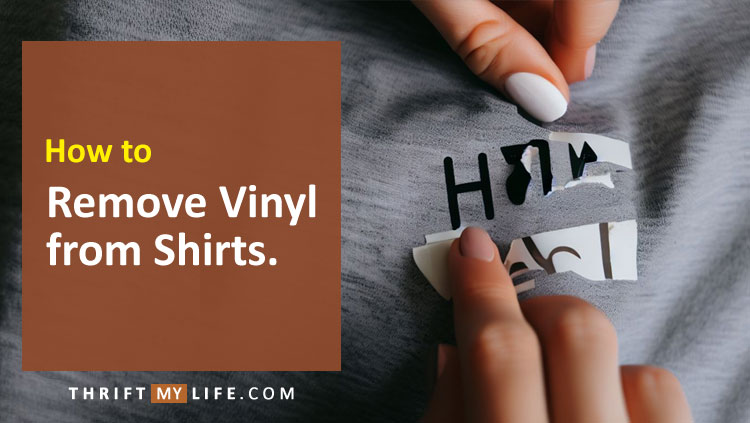
What is Heat Transfer Vinyl and When Might You Want to Remove It?
Vinyl on clothing, such as shirts, jackets, or even shoes, is a heat transfer vinyl (HTV) used to decorate them. This material is slender and bendable, available in various colors and textures, from basic solids to shimmering glitter and eye-catching holographic finishes.
However, even durable vinyl designs can get damaged over time. As much as vinyl can enhance your wardrobe, there are times when you may want to remove it, whether it’s due to a dated design, a simple mishap, or damage.
How to Remove Heat Transfer Vinyl from Shirts
From chemical solvents to basic household items, you have a wide array of options for vinyl removal—even right at home. Looking to tackle stubborn vinyl glue, foil vinyl, or even unwanted vinyl print on a shirt, whether it’s cotton or polyester fabric?
Each approach comes with advantages and drawbacks, so read on to determine which one aligns well with both your material and the specific vinyl you aim to remove.
Using an Iron (The Household Favorite)
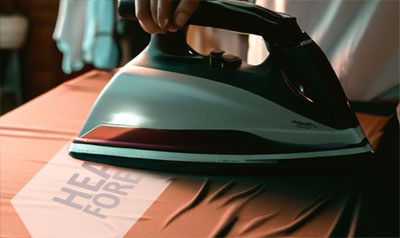
Ironing isn’t just for getting wrinkles out of your clothes—it can also help you get rid of unwanted vinyl designs. The heat from the iron works to loosen the adhesive backing on the vinyl, making it easier to peel off.
How it works: The heat from the iron softens the adhesive on the vinyl, allowing you to lift it away more easily.
- Lay a piece of parchment paper over the vinyl.
- Set your iron to a medium-high heat setting.
- Press down firmly over the parchment paper for about 10-15 seconds.
- Carefully lift an edge to see if the vinyl peels away. If it does, continue to peel it off. If not, apply the iron for a few more seconds.
Removing Vinyl with Wax Paper
For those who don’t have parchment paper, wax paper can be a convenient alternative for removing vinyl.
Instructions:
- Place the wax paper over the vinyl design.
- Set the iron to the highest setting and iron over the wax paper for 15-20 seconds.
- The vinyl should start to melt and adhere to the wax paper.
- Carefully peel off the wax paper, taking the vinyl with it.
- If there is any residual vinyl on the surface, scrape it off with the scraper tool.
Caution: Make sure to keep the iron moving to prevent scorching the fabric. Do not overheat the iron, as excessive heat can damage/burn or discolor the fabric or vinyl. Always unplug the iron when you’re done.
Removing Vinyl with Steam
You can also remove vinyl with steam, which can effectively loosen the adhesive backing, making it easier to remove the vinyl design from your shirt.
How it works: Steam penetrates both the vinyl and the adhesive beneath it, softening the bond and making removal easier.
- Set your iron to the steam setting.
- Place a towel or cloth between the iron and the vinyl area for added protection, especially if you’re dealing with a delicate fabric.
- Apply steam evenly over the vinyl area for several seconds. Be cautious not to concentrate the steam on one spot for too long, as this could risk damaging the fabric.
- Use a pair of tweezers or a scraper tool to lift a corner of the vinyl.
- If the vinyl design is not peeling off easily, you can steam it for a few more seconds.
- Carefully peel off the entire piece of vinyl once a corner is lifted.
Caution:
Exercise caution while using steam, as it can cause burns; consider using heat-resistant gloves for protection. Always perform a test on a small, hidden area of the fabric to ensure it won’t be damaged or discolored. Keep in mind that this method may not be suitable for all types of vinyl or fabrics.
Commercial Vinyl Removers
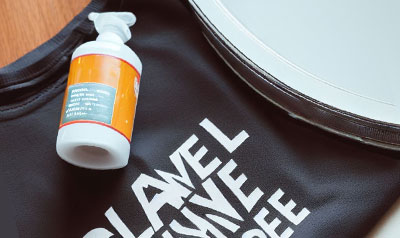
When it comes to specialized solutions for removing vinyl, commercial vinyl removers are your go-to products. Though more expensive, they are highly effective and designed to work quickly.
Some popular commercial vinyl removers include AlbaChem VLR Vinyl Lifter for Fabric, Heat Transfer Vinyl Remover for Fabrics and T-Shirts, Goo Gone Adhesive Remover, Goof Off Adhesive Remover, and CitraSolv Citrus Solvent. You can find these products at your nearest home improvement stores or from online retailers such as Amazon or eBay.
How it works: The special solvents in these commercial products are formulated to dissolve the adhesive that keeps the vinyl attached to your fabric, facilitating easier removal.
- Apply your chosen commercial vinyl remover to the vinyl.
- Wait for the instructed time, usually indicated on the product label, which is generally a few minutes.
- Carefully peel off or wipe away the vinyl.
Caution: Always adhere to the manufacturer’s guidelines and safety precautions outlined on the product label. Make sure to test the product in an inconspicuous area first to ensure it does not damage your fabric.
Goo Gone (Adhesive Remover)
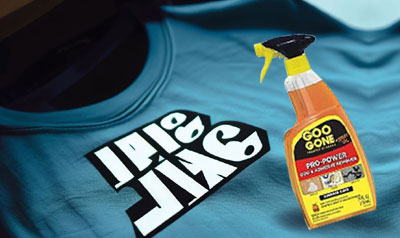
Goo Gone offers a multi-purpose solution for removing adhesives, stickers, and yes—vinyl. Though not as specialized as commercial vinyl removers, it’s still highly effective. You can easily find Goo Gone in stores or online.
How it works: Goo Gone contains citrus-based solvents that weaken the adhesive, allowing the vinyl to be peeled off more easily.
- Apply Goo Gone to the vinyl.
- Wait for a few minutes to allow the product to penetrate the adhesive.
- Peel off or scrape away the vinyl.
Caution: Make sure to read all instructions and safety warnings on the Goo Gone package. Always do a patch test on a small area first.
Acetone (The Chemical Solution)
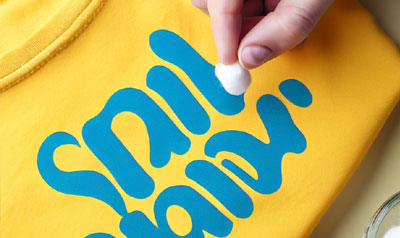
Acetone is not just any solvent; it’s a strong one that is highly effective in breaking down the adhesive holding your vinyl in place. Polymers in the adhesive lose their bonding power when exposed to acetone, allowing for easier vinyl removal.
How it works: The acetone works at the molecular level, breaking down the long chains of polymers in the adhesive, which in turn loosens the vinyl’s grip on your fabric.
- Dampen a cloth with acetone.
- Gently rub the cloth over the vinyl area.
- Use tweezers to lift off the loosened vinyl.
Caution: Given its potency, acetone can be harsh on certain fabrics. Always do a spot test in an inconspicuous area before full application. Also, ensure you’re working in a well-ventilated space due to acetone’s strong fumes.
Rubbing Alcohol (The Quick Solvent Method)
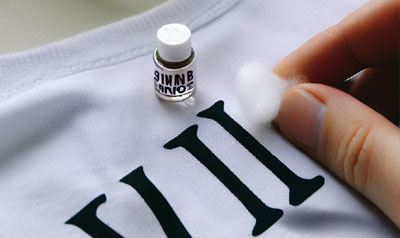
Rubbing alcohol, also known as isopropyl alcohol, is commonly used for medical purposes. This colorless liquid with a strong odor also serves as an effective solvent for removing vinyl. It works by dissolving the adhesive bond between the vinyl and the fabric, making it a quick and practical option for vinyl removal.
How it works: Rubbing alcohol targets the adhesive elements that keep the vinyl attached to the fabric, allowing for easy peeling or scraping.
- Soak a cotton ball or pad with rubbing alcohol.
- Gently apply the soaked cotton over the vinyl area until the adhesive starts to weaken.
- Carefully peel off or scrape away the loosened vinyl with your fingers or tweezers.
Caution: Rubbing alcohol is flammable and may be harsh on some fabrics. Always use it in a well-ventilated space and conduct a patch test on a hidden part of the fabric first.
Petroleum Jelly (The Overnight Method)
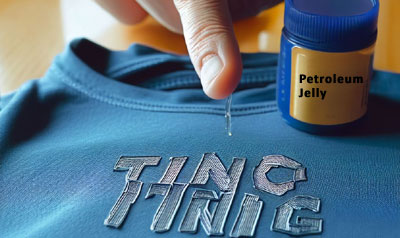
Petroleum jelly, a semi-solid mixture of hydrocarbons, not only has moisturizing properties but also works well in loosening adhesives. This makes it an effective, albeit slower, option for removing vinyl from shirts. Its ability to penetrate the adhesive ensures that you can peel off the vinyl more easily and without residue.
How it works: Over a span of several hours or even overnight, the petroleum jelly works to infiltrate the adhesive bonding the vinyl to your fabric, making it more pliable and easier to remove.
- Generously apply petroleum jelly onto the vinyl area.
- Allow it to sit for several hours, or for best results, leave it overnight.
- Use a blunt object like a butter knife or a credit card to scrape off both the jelly and the softened vinyl.
Caution: As petroleum jelly is oil-based, it has the potential to stain some fabrics. Always perform a patch test on a hidden area of the fabric before full application.
Hair Dryer (The Convenient Choice)
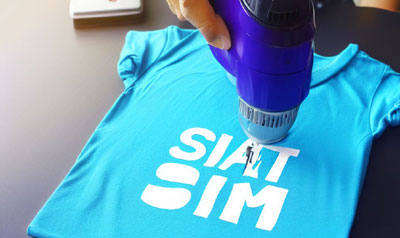
The hair dryer offers a quick and handy alternative to the iron or heat press. It’s also something most people already have at home.
How it works: The hot air from the hair dryer softens the adhesive, making it easier to lift the vinyl from the fabric.
- Hold the hair dryer about 6 inches away from the vinyl.
- Move it back and forth over the area until the edges start to lift.
- Use your fingers or tweezers to peel off the vinyl.
Caution: Be mindful of the heat setting on your hair dryer; using too high a heat setting could damage the fabric. Always keep the dryer moving to avoid concentrating heat on one area.
Heat Press (The Pro Method)
If you have access to a heat press, this method is often considered more effective but is usually less available in typical households.
How it works: The heat press offers more uniform heat and pressure compared to an iron, which can make vinyl removal more efficient.
- Place a piece of parchment paper over the vinyl design.
- Lower the heat press and hold for about 10-15 seconds.
- Lift the press and peel the vinyl, which should come off easily.
Caution: Always follow the manufacturer’s instructions for operating the heat press, and wear heat-resistant gloves to protect your hands.
Cold Temperatures (Freezer or Ice)

Cold temperatures are effective because they cause the vinyl to become brittle, making it easier to peel off. This method works especially well for delicate fabrics that might be damaged by heat or chemicals.
- Place the shirt in a plastic bag.
- Store it in the freezer for several hours.
- Or press the ice cube against the vinyl area for several minutes.
- Once the vinyl becomes brittle, peel it off.
Both methods (freezer and ice cubes) work on the principle of making the vinyl brittle, thus facilitating its easy removal.
Additional Tips for Removing Different Types of Vinyl from Fabric
- Glitter vinyl: Glitter vinyl may be more difficult to remove due to the added texture. You may need to heat the glitter vinyl for a longer period of time and use more pressure when peeling it off. You may also need to use a commercial vinyl remover to remove any remaining adhesive residue.
- Vinyl stickers: Vinyl stickers are usually easier to remove than other types of vinyl. You can simply heat the sticker and peel it off. If there is any adhesive residue left behind, you can remove it with rubbing alcohol or a commercial vinyl remover.
- Iron-on vinyl: Iron-on vinyl is designed to be bonded to fabric, so it can be more difficult to remove. You will need to heat the iron-on vinyl for a longer period of time and use more pressure when peeling it off. You may also need to use a commercial vinyl remover to remove any remaining adhesive residue.
Related Questions
Is Rubbing Alcohol Safe for Fabric?
While rubbing alcohol is generally considered safe for most fabrics, it’s crucial to perform a spot test on an inconspicuous area of the fabric beforehand. This is because rubbing alcohol has a drying effect and could damage certain materials.
How Does Alcohol Affect Vinyl?
Alcohol doesn’t melt vinyl, but it does dissolve the adhesive that keeps the vinyl attached to the fabric. This breakdown makes it easier to remove the vinyl from the garment.
Is Baking Soda Effective for Cleaning Vinyl?
Baking soda can be a useful cleaner for vinyl. However, it’s essential to exercise caution while using it. Mixing one part baking soda with two parts water forms a paste that can be applied to the vinyl. A gentle scrubbing with a soft cloth should lift dirt without scratching the vinyl’s surface. Remember to rinse the area with water and blot it dry afterward.
Can You Use Water to Clean Vinyl?
No, water alone won’t remove the vinyl. For a more effective cleaning, it’s advisable to use a mild soap or detergent along with water. Apply your chosen soap to a damp cloth, wipe down the vinyl surface, then rinse the area with water. Finish by blotting the area dry to avoid any water marks.
Can you clean vinyl with dish soap?
Mild dish soap can effectively clean vinyl. Simply add a small amount of dish soap to a damp cloth and wipe down the vinyl surface. Rinse the soapy residue off with water and blot the area dry. Always use mild dish soap to prevent potential damage to the vinyl.
Related Guides:

